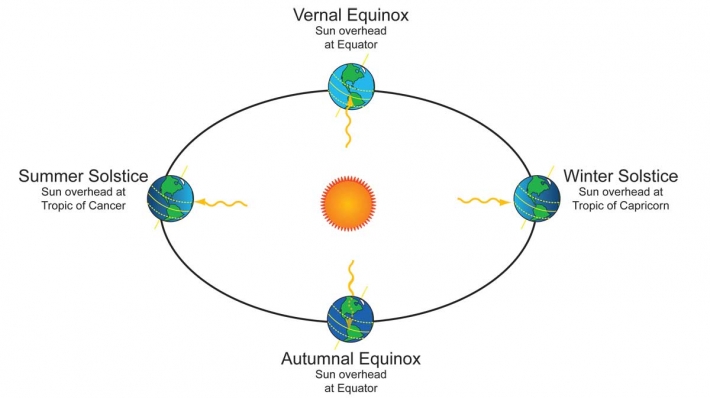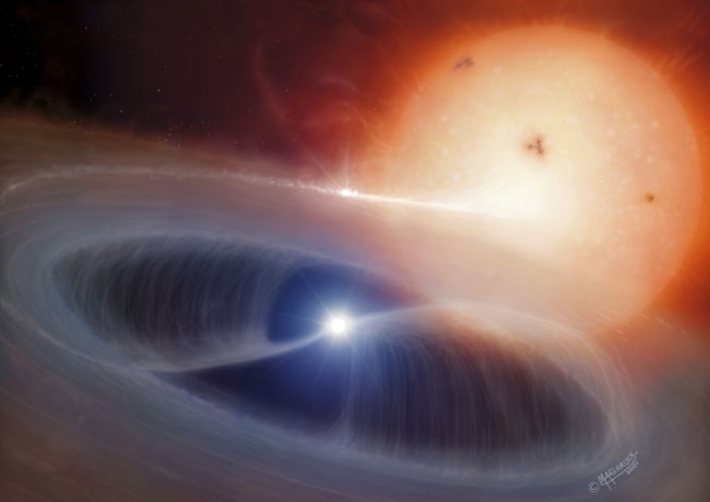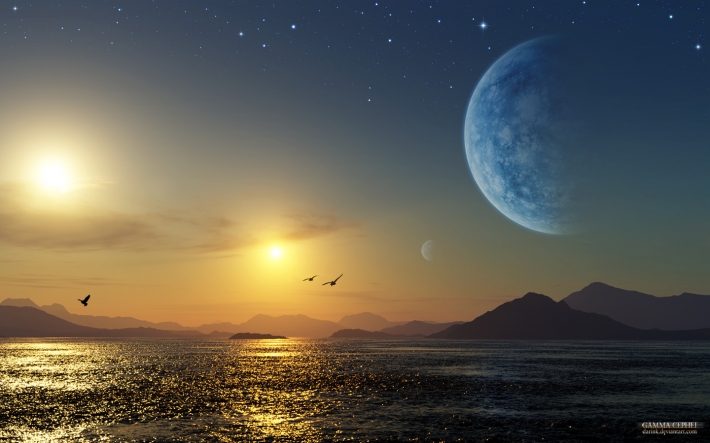To inhabitants of George R R Martin's fictional world of Westeros, the seasons seem to hold not just practical, but symbolic significance. The Starks repeat ominously that 'Winter is Coming' and the ruling Lannisters in King's Landing are said to be enjoying the remaining time of a summer that is drawing to a close. Near the opening of book one, we are told that it is the "ninth year of summer, and the seventh of Bran's life". The Seven Kingdoms have enjoyed seven years of summer, peace and happiness and the maesters predict an equally long, and bitter, winter to follow. Considering the structure of Earth years are marked by a cycle of four, fairly regular, seasons, the thought of Westeros' long periods of summer or winter is counter-intuitive. Some scrutiny into how they could work may help us understand their importance to the wider plot.
Different regions of Westeros and Essos have very different climates: the North seems to be in the grip of a perpetual winter whereas Southern regions, such as Dorne and the Reach, have warm, Mediterranean-like climates. If the coming of winter enacts a change across the whole of the planet, then it seems that the North should expect a very cold winter indeed. This suggests that the talk of changing seasons could be less literal and more symbolic of political and social climate. That's not to say that the two are mutually exclusive. This article aims to explore the long and erratic seasonal changes on the planet which houses Westeros as a literal change, considering how clues from the novels could guide us towards the most likely scientific explanation, assuming that it follows rules akin to those of our universe.
What makes the seasons in Westeros so hard to explain is their unpredictability. The current summer has been a particularly long one of seven years, but some stories predict eternal summers and winters, and not even the maesters are quite sure as to when the next winter will begin. In the medieval-like world of Westeros, without central heating or advanced farming technology, the unpredictability of seasons could be detrimental to not just the political and economic state, but to the survival of individuals.
A group of graduate students in the Department of Physics and Astronomy at John Hopkins University, Maryland, have written a wonderfully tongue-in-cheek paper, for submission to the esteemed 'Oldtown Journal of Evil Omens', which attempts to explain the erratic seasons experiences in Westeros. While not the most reliable of papers to base an article on, their analysis is remarkably thorough considering their time is reputably directed towards solving problems of a less fantastical kind. It's true testament to the productivity that can be achieved while avoiding a long academic project.
The paper concludes that Westeros must be part of a planet in a binary star system, but before reaching this conclusion, the team rule out other explanations that have been presented to explain the seasons in 'A Song of Fire and Ice'.
Axial Tilt
Planet Earth has an axial tilt of 23.4°, which provides the basis for the varying climate between the Northern and Southern hemispheres. For half of the year, the Northern hemisphere tilts towards the sun, causing summer in that region, and it points away for the other half, causing winter. This is reversed for the Southern hemisphere. We have the moon to thank for the stability of this tilt. Without the gravitational pull of the moon, Earth's axis of rotation would be unstable and erratic, resulting in unpredictable seasons.

Daenerys often refers to Khal Drogo as 'Moon of my life'
Credit: HBO
However, the planet in 'A Song of Fire and Ice' does appear to have a moon, which should stabilise the planet's tilt. The moon in the novels is referenced many times by different characters - for example, the Dothraki believe that the moon is a Goddess, wife to the Sun - and it appears to undergo similar phases to Earth's own satellite. The moon is often mentioned in relation to women's cyclic 'moon blood', so we can perhaps assume their months are similar to ours and are governed by the cycles of the moon.
The team at John Hopkins rule out this theory, but it could be deemed possible if the moon over Westeros is smaller or more remote. This would result in a weaker force acting upon the planet and insufficient stabilisation of its axis of rotation. However, if the moon was further away or smaller in the sky, it is unlikely to be mentioned as often as it is in the books, or to play such a large part in the people's folklore.
The Qartheen believe that there used to be a second moon in the sky over Westeros, and that it was in fact a huge dragon's egg. Their stories say that this egg cracked when it got too close to the Sun and dragons hatched from it. At a push, this could be used to explain the irregular seasons, as the destruction of this second moon and the removable of its stabilising force could have altered the planet's rotational axis for a significant period of time.
An example of a planet in our own universe with unusual seasons as a result of its axial tilt is Uranus. Uranus' tilt of 97.77° means that its axis of rotation is almost parallel with the plane of the solar system. At the Uranian solstices, one pole faces the sun, the other is pointed away, so each pole gets approximately 42 years of summer and 42 years of winter. However, though these seasons are remarkably long, they are still very regular, unlike those experienced in Westeros.
Elongated Orbit
The Earth's orbit is very regular, almost circular in shape so its seasons are of an even length. Summer lasts for roughly the same amount of time as winter, without taking other factors into account. However, a planet with an elliptical orbit would experience one season for longer than the others.

Earth's orbit around the Sun
Credit: NASA
The aphelion point in an orbit is the point where the planet is furthest from the sun, whereas the perihelion point is where the planet is at its closest to the sun. It is not hard to imagine that the length of a particular season could be extended if a planet's orbit dictates it spend a more time either passing close to the sun or passing far from it. This could result in a longer summer or a longer winter, though the difference in lengths would remain the same each passing year.
This theory is also ruled out by most because it explains seasons of unusual length, but does not result in unpredictable seasons. However, in combination with other factors, it could help to explain the erratic nature of Westerosi seasons.
Geography
There are a number of factors that could contribute to unpredictable seasons on the planet on which Westeros lies. One of which could be chaotic ocean currents. For an example on Earth, we could look to the North Atlantic current of the Gulf Stream, which warms Great Britain, resulting in milder winters than experienced in other countries at the same latitude. The Gulf Stream moves warm water from the Gulf of Mexico at the equator, to the coast of Greenland, warming landmasses it encounters on the way. If similar currents are keeping Westeros warm enough to enjoy a long, balmy summer, and if these currents were to stop, the climate would be changed drastically. Localised changes in climate, natural disaster, or any number of other factors could cause narrow passages of water to freeze, and this could have an effect on the current further south.
Natural disasters, such as volcanoes, could produce erratic changes to the climate. Pollution from volcanic eruptions could fill the air and could change the overall temperature on the planet surface. This could explain the seasons in Westeros, as the maesters may be aware that a natural disaster is imminent but they wouldn't be able to predict exactly when the change would happen. Just because there are no mentions of volcanoes or natural disaster doesn't mean that this isn't a secret kept hidden from the ordinary people of Westeros.

Grumpy Ygritte
Yet the students at John Hopkins university rule out all these explanations in favour of another. (They do acknowledge that magic could play a factor in the Westeros seasons...) They suggest that the planet on which Westeros is based is in orbit around two stars. Such a situation would mean that the planet's orbit would be affected by both stars and subject to varying periods of warmth and cold as it passes by the two stars, not necessarily in a regular way that could be predicted. There are a number of ways in which this binary star system could exist: a p-type orbit, where the planet orbits both stars; an s-type orbit, where the stars are relatively far apart - the planet orbits one of them, and planet and star together orbit the other star; or more complicated orbits. However, this final system can be disregarded for the planet in 'A Song of Fire and Ice' because more complicated orbits in a binary system would probably result in a climate that is too unstable to support life.

A DQ Hercules system where the stars are so close that the white dwarf strips away the outer atmosphere of the other star in the binary system.
Credit: Mark Garlick / Space Art
Based on this theory of a binary star system, the team modelled the potential seasonal pattern for 100 Westerosi years. The severity and duration of winters varied erratically. There emerged a pattern of 'multi-year spells' of hot summers and cold winters followed by cool summers and mild winters. From evidence in the novels that the characters expect their long, hot summer to precede a particularly cold, harsh winter, it seems this is a pattern akin to that seen in Westeros. The results of the model were also unpredictable, in line with the erratic weather of Westeros.
The results suggest that winters in this system could last for as little as 600 Westerosi days and the longest up to 850 days. It's not clear how many days there are in a Westerosi year. (If someone can enlighten me here, I'd be very grateful) Humans in Westeros appear to live comparable lifespans to those on Earth and appear to age at the same rate, taking into account their way of measuring time. Therefore it seems quite likely that they have the same, or at least a similar, number of days in each year. If there are the same number of days in a Westerosi year as an Earth year, then the longest winter could be approximately two and a third years. Not quite the seven years experienced in Westeros at the start of the 'A Song of Fire and Ice' series...
It seems that a binary star system is the only way to explain the irregularity of the seasons in Westeros. As the John Hopkins University team stated so accurately: "One sun and one planet give periodic, vanilla orbits. We must abandon Keplerian monogamy and explore multiple bodies. Fortunately, the many-body problem has been solved repeatedly (some might say gratuitously) in Westeros. Our planet will have two stars."

Gamma Cephei
Credit: DarinK / Deviantart
A further suggestion, contributed by Professor Mike Merrifield (whose video on the subject can be found in the references below) is that Martin's planet is orbiting a variable star. Such stars burn in an unstable manner, showing fluctuations in their brightness and temperature. This could be due to expansion and contraction as part of the ageing star's process, the frequency of which may increase over time, or due to flares and eruptions on the surface. Professor Merrifield seems to suggest this theory after questioning why, if the planet exists in a binary star system, is the second star never mentioned in the novels or television series. He also muses that the second star could simply not be large, bright or close enough to be noteworthy. This would suggest that the s-type binary star system could be the most plausible.
Despite all this, George R R Martin may surprise us by revealing that seasons in Westeros are simply a persistent analogy for the political and social climate of the world, and that winter, in a literal sense, is in fact, not coming. The seasons already hold great symbolic significance, especially to the Stark's, whose house motto seems to lament the fact that 'winter is coming'. Eddard Stark connects Summer to childhood: "Summer will end soon enough, and childhood as well." The Stark children have had a pleasant Summer upbringing, during peacetime, surrounding by their family and in good favour with the current ruler. However, when a series of tragic events throws the entire family into unexpected misfortune, their house motto seems to predict further suffering. Daenerys also undergoes a 'coming of age', but her successes increase as she approaches adulthood. It is unsurprising then why it is the Stark household that fears so greatly the coming of winter and the next generation's adulthood.
Martin has already stated in an interview with Weird Tales Magazine that his explanation to the changing seasons will come eventually, and when it does, it will be a fantasy rather than a science fiction explanation. Author intention, for the purposes of this blog, is irrelevant, and George R R Martin deemed a killjoy for ruining our fun. For the existing books at least, ignoring the existence of dragons and white walkers, the world of Westeros seems to harbour a sense of realism, an especially violent and misogynist, gritty realism, that some have likened to the reality of life in medieval times. (One of the few signs of magic in the world is the existence of dragons.) Therefore, a scientific explanation would, even temporarily, satisfy some readers with the sense that the world operates on carefully considered and plausible mechanics. Martin also states in that interview that he prefers magic with a sense of mystery, that he feels adds to the magic of the story rather than diminishes it. He doesn't buy into the idea that magic should become an 'alternate kind of science' to be believable. So it seems he and I are destined to disagree, and though he might not agree with this analysis, I'd like to think he'd appreciate such enthusiastic explorations into his world.
References & Further Reading
- Kostov et al, 'Winter Is Coming', Oldtown Journal of Evil Omens (2013).
- Martin, 'A Song Of Fire And Ice' series, Voyager Books (1996 - 2011).
- Merrifield, 'Why Winter Is Coming' Deep Sky Videos (2014).
- 'George R R Martin On Magic Vs. Science', Weird Tales Magazine (2007).
- 'Game Of Thrones' TV series, HBO (2011-2013).
Listing image: HBO
